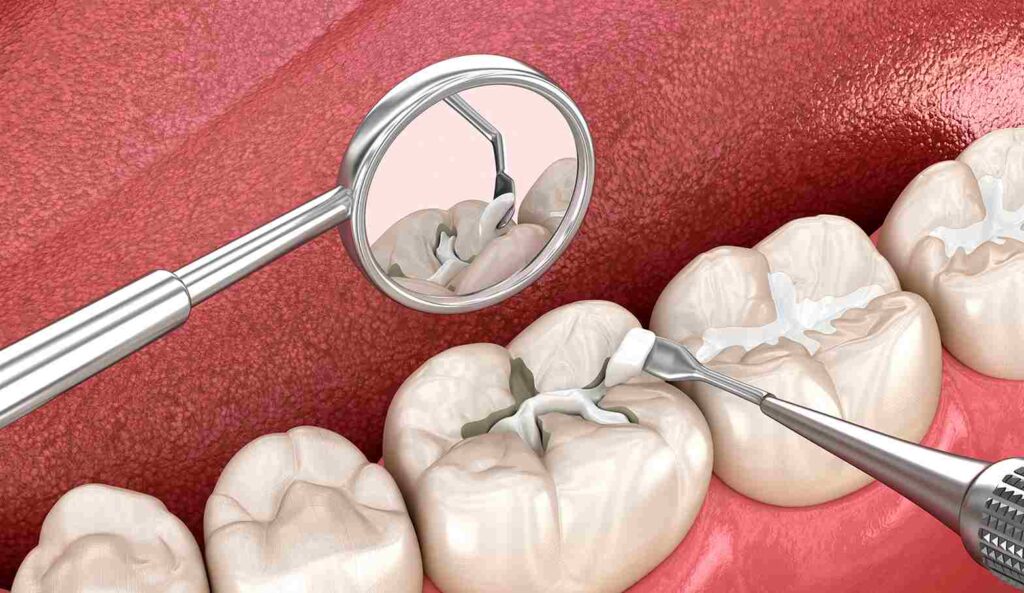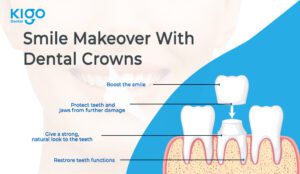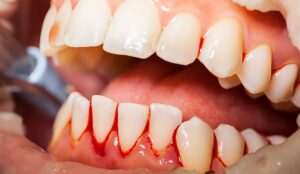Dental Fillings
Uncompromised quality
We use quintessential quality materials and stringent sterilisation protocols to ensure that you don't have any medical or dental complications in future.
Anxiety Free Dentistry
Experience the treatment process in a pleasant atmosphere from handpicked expert clinicians, with unparalleled clinical etiquette, to ensure exemplary health care.
Best in class outcomes
We strive our best, so that we can keep our promise of delivering the individualized smiles that we have reimagined for you with latest techniques and technologies.
Restore your smile, protect your teeth with dental fillings


Keeping up with regular dental checkups is something we stress at Kigo Dental. Cavities can lead to tooth decay and painful discomfort, even with diligent attention paid to one’s oral hygiene routine. Dental fillings are a popular procedure for repairing decayed or broken teeth and protecting healthy tooth structure.
When tooth decay occurs, it can be remedied using materials known as dental fillings to restore the affected tooth. Once the decayed tooth structure has been removed, the filling material is inserted into the cavity. Composite resin, porcelain, gold, or amalgam (a mixture of metals) are some materials that could be used for the filling.
A tooth filling may be necessary for a variety of reasons.
1. Cavities and decay
As one might expect, cavities are the leading cause of needing a dental filling. Bacteria in the mouth produce acids that eat away at tooth enamel, eventually exposing the sensitive dentin below. Cavities in the teeth can be repaired with dental fillings to stop the spread of decay.
2. Cracked or chipped teeth
Trauma, grinding teeth, and biting down on hard objects are all potential causes of tooth damage. If not treated, these fractures and chips can lead to tooth sensitivity, pain, and even severe damage. With dental fillings, you can repair the damage to your tooth and stop it from getting worse.
3. Worn-down teeth
Teeth can deteriorate over time due to natural wear and tear and the wear caused by grinding or consuming acidic foods and beverages. Tooth sensitivity, pain, and even more decay might result from this. A dental filling might be used to prevent future damage and restore the tooth’s original shape.
4. Cosmetic reasons
Besides restoring a tooth’s function, dental fillings can also be utilized for aesthetic purposes, such as closing spaces between teeth or masking tooth discolouration or damage.
Existing fillings should be replaced because they can wear out, become loose, or fall out over time, exposing the tooth to decay. Tooth decay can be prevented by placing a dental filling in place of an old one.
5. Root canal treatment
A filling may be necessary to restore the tooth’s structure after a root canal and stop the decay from spreading.
Get an appointment with our specialist to find out if a dental filling is necessary if you have any of these problems.
Several different dental filling options exist, including:
1. Amalgam fillings
Silver fillings are amalgam restorations combining silver, copper, and mercury. Although they survive long, their mercury level may be off-putting to some.
2. Composite fillings
Composite fillings are a hybrid material composed of glass microspheres. They are frequently used to treat cavities in front teeth since they may be made to match the patient’s natural tooth colour.
3. Ceramic fillings
Dental ceramics create ceramic fillings, commonly known as porcelain fillings. They can be shade-matched to your natural teeth so that they won’t stand out.
4. Gold fillings
Gold fillings last a long time and cause minimal discomfort. They may not be as aesthetically beautiful as other filler options and can be more expensive.
5. Glass ionomer fillings
These are composites of glass and acrylic. They work well as fillings in locations that don’t experience as much pressure from biting, such as the gum line.
Many parameters, such as the cavity’s location, size, and preferences, will determine the optimum filling for you. Meet our experts now so they can advise you on the best filling material for your condition.
These are the typical steps involved in a dental filling procedure:
1. Reduce pain by numbing the area
Your dentist will administer a local anaesthetic to the region around the damaged tooth before beginning the treatment. Make sure you don’t feel any pain or discomfort during the process.
2. Removing the decay
Your dentist will use a dental drill or laser to remove the infected tissue.
3. Cleaning and preparing the tooth
After removing the decay, cleaning and roughening the tooth’s surface is done to prepare the teeth for the filling.
4. Placement of the filling
Next, the filling material will be placed into the cavity to fit the created cavity. To solidify the filling material, your dentist will use a special light.
5. Finishing and polishing
The dentist will polish the filling once it has cured to remove any rough spots and make it look like a natural part of your tooth.
It can take anywhere from half an hour to an hour to complete the full treatment, depending on the size and location of the cavity. It’s normal to feel sensitive or uncomfortable immediately following the treatment, but such feelings should fade quickly.
If you want to ensure optimal recovery and avoid issues, it’s crucial to adhere to the dentist’s aftercare guidelines.
There are a lot of potential outcomes if you put off getting a filling.
1. Cavity Development
When decay is not treated, it spreads, and the cavity deepens. Over time, this can necessitate more painful and costly dental procedures like a root canal or tooth extraction.
2. Tooth Sensitivity
When a cavity progresses, a tooth’s inner layers may become vulnerable to microorganisms and extreme temperatures. Because of this, you may experience pain or discomfort whenever you try to eat or drink.
3. Bad Breath
Bad breath can be caused by decaying teeth, whose rotting pulp releases an odour.
4. Infection
There is a risk of systemic infection if dental decay reaches the pulp (nerve) of the tooth.
5. Difficulty eating
Decay can weaken a tooth, making it difficult to bite and chew as it spreads.
After getting a dental filling, following some post-treatment care instructions is essential to ensure proper healing and prevent any complications. Here are some tips for post-treatment care for dental fillings:
- Avoid eating or drinking for at least one hour after the procedure or until the anesthetic wears off. This will prevent you from accidentally biting or burning the numb area.
- Be gentle when brushing and flossing around the filled tooth for 24-48 hours after the procedure. This will help to avoid irritating the area and causing any discomfort.
- Avoid eating hard or sticky foods, such as candy or chewing gum, for the first 24 hours after the procedure. This will help to avoid dislodging or damaging the filling.
- Be aware of any sensitivity or discomfort around the filled tooth. This is normal and should subside within a few days. If the discomfort persists, contact your dentist.
- If you experience swelling or pain, apply a cold compress to the affected area. This will help to reduce swelling and discomfort.
- Attend any follow-up appointments scheduled by your dentist. They may want to check the filling and ensure it is adequately bonded to the tooth.
- Maintain good oral hygiene habits, including brushing twice daily, flossing daily, and visiting your dentist regularly for checkups and cleanings.
- By following these post-treatment care instructions, you can help ensure that your dental filling stays appropriate and lasts as long as possible.
We at Kigo Dental are committed to providing you with the best dental care available, and we do so with a smile.
Our entire staff, from receptionists to dental hygienists and assistants, is committed to providing you with the best quality dental care possible.
From the time you walk through the door and every time you revisit, you will experience this firsthand.
Kigo Dental has a team of experienced and skilled Orthodontists and other specialized dentists who specialize in providing high-quality dental care and treatments, utilizing the latest technologies and techniques to ensure the best patient outcomes.
FAQ's
Dental fillings are materials that are used to repair damaged or decayed teeth. They are designed to restore the tooth’s structure and function and prevent further decay.
You may need a dental filling if you have a cavity, a chipped or broken tooth, or a damaged filling. Your dentist can examine your teeth and recommend the appropriate treatment.
Dental fillings can be made of various materials, including amalgam, composite resin, porcelain, and gold. The filling that is best for you will depend on several factors, such as the location and extent of the damage, your oral health, and your budget.
The lifespan of a dental filling can vary depending on several factors, such as the material used, the location of the filling, and your oral hygiene habits. Generally, dental fillings can last anywhere from 10 to 20 years or more.
Getting a dental filling is typically not painful, as the dentist will use a local anaesthetic to numb the area around the affected tooth. However, you may experience some discomfort or sensitivity after the procedure.
You should avoid eating or drinking for at least one hour after the procedure or until the anesthetic wears off. After that, you can resume your normal eating and drinking habits.
To care for your dental fillings, you should maintain good oral hygiene habits, including brushing twice daily, flossing daily, and visiting your dentist regularly for checkups and cleanings. You should also avoid chewing on hard or sticky foods that could damage the filling.
Blogs






Wisdom Teeth: Understanding the What, Why, and When
Wisdom teeth, also known as third molars, are often a source of concern for many people. They can lead to various dental issues, including wisdom






Smile Makeover with Dental Crowns: Types, Overview & cost
A smile is one of the most attractive features a person can have. It can boost your confidence, make you more approachable, and even improve






Beyond the smile: Exploring the crucial role of teeth in your overall health
Teeth are often linked to the ability to smile, eat, and express oneself. However, teeth serve many other vital purposes as well. Your teeth have






The Silent Threat: How Gum Diseases Lead to Tooth Loss
Having strong teeth and gums is a reflection of your entire well-being, not simply your appearance. Despite this, many people don’t give their gums the






The Importance of Orthodontists in Clear Aligner Treatment: Avoiding Problems and Ensuring Successful Outcomes
More and more individuals are seeking out clear aligner treatment as a way to improve their smile in a way that is both subtle and






Understanding Abnormal Dental Habits in Children and the Importance of Control
As parents and caregivers, we play a pivotal role in shaping our children’s habits and behaviors, especially when it comes to their oral health. However,






Wisdom Teeth: Understanding the What, Why, and When
Wisdom teeth, also known as third molars, are often a source of concern for many people. They can lead to various dental issues, including wisdom






Smile Makeover with Dental Crowns: Types, Overview & cost
A smile is one of the most attractive features a person can have. It can boost your confidence, make you more approachable, and even improve






Beyond the smile: Exploring the crucial role of teeth in your overall health
Teeth are often linked to the ability to smile, eat, and express oneself. However, teeth serve many other vital purposes as well. Your teeth have






The Silent Threat: How Gum Diseases Lead to Tooth Loss
Having strong teeth and gums is a reflection of your entire well-being, not simply your appearance. Despite this, many people don’t give their gums the






The Importance of Orthodontists in Clear Aligner Treatment: Avoiding Problems and Ensuring Successful Outcomes
More and more individuals are seeking out clear aligner treatment as a way to improve their smile in a way that is both subtle and






Understanding Abnormal Dental Habits in Children and the Importance of Control
As parents and caregivers, we play a pivotal role in shaping our children’s habits and behaviors, especially when it comes to their oral health. However,






Wisdom Teeth: Understanding the What, Why, and When
Wisdom teeth, also known as third molars, are often a source of concern for many people. They can lead to various dental issues, including wisdom






Smile Makeover with Dental Crowns: Types, Overview & cost
A smile is one of the most attractive features a person can have. It can boost your confidence, make you more approachable, and even improve






Beyond the smile: Exploring the crucial role of teeth in your overall health
Teeth are often linked to the ability to smile, eat, and express oneself. However, teeth serve many other vital purposes as well. Your teeth have






The Silent Threat: How Gum Diseases Lead to Tooth Loss
Having strong teeth and gums is a reflection of your entire well-being, not simply your appearance. Despite this, many people don’t give their gums the






The Importance of Orthodontists in Clear Aligner Treatment: Avoiding Problems and Ensuring Successful Outcomes
More and more individuals are seeking out clear aligner treatment as a way to improve their smile in a way that is both subtle and






Understanding Abnormal Dental Habits in Children and the Importance of Control
As parents and caregivers, we play a pivotal role in shaping our children’s habits and behaviors, especially when it comes to their oral health. However,






Wisdom Teeth: Understanding the What, Why, and When
Wisdom teeth, also known as third molars, are often a source of concern for many people. They can lead to various dental issues, including wisdom






Smile Makeover with Dental Crowns: Types, Overview & cost
A smile is one of the most attractive features a person can have. It can boost your confidence, make you more approachable, and even improve






Beyond the smile: Exploring the crucial role of teeth in your overall health
Teeth are often linked to the ability to smile, eat, and express oneself. However, teeth serve many other vital purposes as well. Your teeth have






The Silent Threat: How Gum Diseases Lead to Tooth Loss
Having strong teeth and gums is a reflection of your entire well-being, not simply your appearance. Despite this, many people don’t give their gums the






The Importance of Orthodontists in Clear Aligner Treatment: Avoiding Problems and Ensuring Successful Outcomes
More and more individuals are seeking out clear aligner treatment as a way to improve their smile in a way that is both subtle and






Understanding Abnormal Dental Habits in Children and the Importance of Control
As parents and caregivers, we play a pivotal role in shaping our children’s habits and behaviors, especially when it comes to their oral health. However,






Wisdom Teeth: Understanding the What, Why, and When
Wisdom teeth, also known as third molars, are often a source of concern for many people. They can lead to various dental issues, including wisdom






Smile Makeover with Dental Crowns: Types, Overview & cost
A smile is one of the most attractive features a person can have. It can boost your confidence, make you more approachable, and even improve






Beyond the smile: Exploring the crucial role of teeth in your overall health
Teeth are often linked to the ability to smile, eat, and express oneself. However, teeth serve many other vital purposes as well. Your teeth have






The Silent Threat: How Gum Diseases Lead to Tooth Loss
Having strong teeth and gums is a reflection of your entire well-being, not simply your appearance. Despite this, many people don’t give their gums the






The Importance of Orthodontists in Clear Aligner Treatment: Avoiding Problems and Ensuring Successful Outcomes
More and more individuals are seeking out clear aligner treatment as a way to improve their smile in a way that is both subtle and






Understanding Abnormal Dental Habits in Children and the Importance of Control
As parents and caregivers, we play a pivotal role in shaping our children’s habits and behaviors, especially when it comes to their oral health. However,
LET'S TALK
Book your Appointment
Appointment Timings: Mon-sat: 10:00 am- 8:00 pm |
Sun: 10:00 am - 1:00 pm
Contact
We would love to be a part of your Smile Reimagining Journey...
- 2nd Floor, QUBE, Plot No: 3-64/A, Kavuri Hills Rd, Jubilee Hills, Hyderabad, Telangana 500033
-
+91 9998884398
- kigodental@gmail.com
-
Mon - Sat: 10:00 am - 8:30 pm
Sun: 10:00 am - 1:00 pm